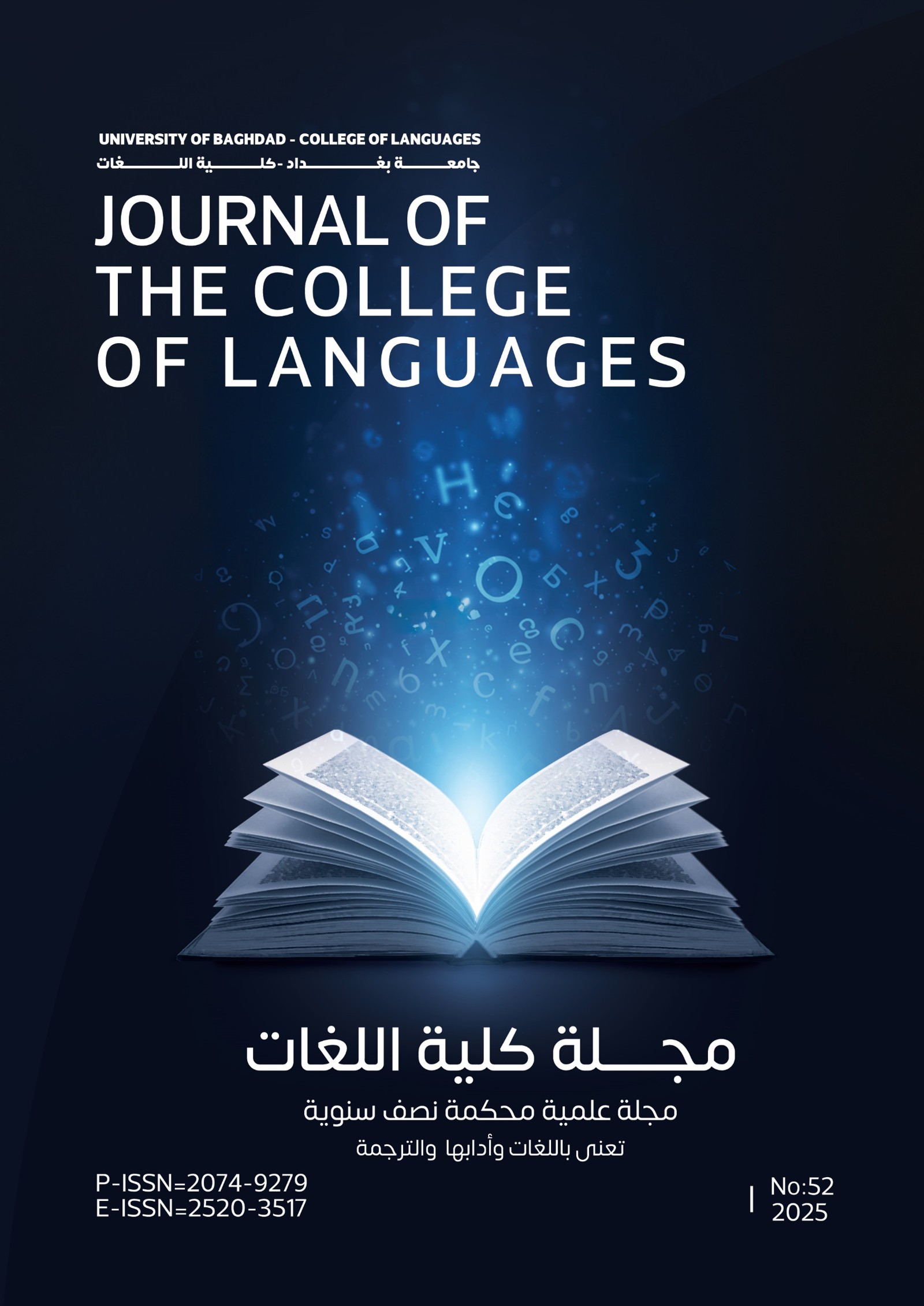The morphological structure of nouns and verbs in the novel "Astonishment" by the novelist Aharon Applefield, Morphological study.
מבנה שמות עצם והפעלים ברומן תימהון לסופר אהרון אפלפלד עיון מורפולוגי
DOI:
https://doi.org/10.36586/jcl.2.2023.0.47.0321Keywords:
morphology, morphology of Hebrew, noun, verb., מורפולוגיה, המורפולוגיה העברית, שם, פועל,Abstract
This research sheds light on the morphological structure of nouns and verbs in the novel "ASTONISHMENT" by the novelist Aharon Applefield by analysing selected models from the novel in a morphological analysis in order to identify the most important morphological features of this structure according to a statistical analytical approach.
The morphological structure is the main pillar of the linguistic structure of the literary text. Morphology is the science that studies the word, by which its structure and original letters are known, and the change that has occurred to it. The aesthetics of the fictional text is reflected in this structure, through which the writer conveys his ideas and narrations to the reader. The research focused on important issues in the structure of nouns, such as definition and invocation, singular, dual and plural. It also touched on the structure of the verb in terms of weight and temporal significance.
The research concluded that the morphological structure of nouns and verbs is characterized by clarity and abundance of expression and significance. The novelist Aaron Applefield employed defined nouns in a large proportion compared to nouns, due to the connotations it gave to remove ambiguity and ambiguity from the text, as well as more than the use of active verbs and moved some thing away from built verbs to the unknown in order to deliver his message easily and conveniently. He also concluded that the writer was using verbs with a single structure in order to maintain the dynamics of events.
תקציר:
המאמר הזה שופך על המבנה המורפולוגי של השמות והפעלים ברומן "תימהון" של הסופר "אהרון אפלפלד" על ידי ניתוח דוגמאות נבחרות ניתוח מורפולוגי כדי לעמוד על המאפיינים המורפולוגיים של המבנה הזה לפי השיטה האנליטית – סטטיסטיקאית.
המבנה המורפולוגי הוא אחד מעמודי התווך של המבנה הלשוני של הטקסט הספרותי, המורפולוגיה היא המדע החוקר את המילה, ובה ניתן לדעת את מבניה והאתיות המקוריות שלה ומה שעברה משינוי. האסתטיקה של הטקסט הספרות מתגלה בו ומתוכו הסופר מעביר את רעיונותיו לקורא. המאמר מתמקד בנושאים חשובים במבנה השמות כגון: היידוע, היחיד, הזוגי והרבים, גם כן עיינו במבנה הפועל מבחינת הבניין והזמן.
מאמר זה הראה שמבנה המורפולוגי של השמות והפעלים מתאפיין בבהירות ובדיוק ההבעה. הסופר אהרון אפלפלד השתמש בשמות מיודעים יותר משמות לא מיודעים בגלל תפקידה בהסרת העמימות ואי בהירות מהטקסט, גם כן הרבה מהשימוש בפעלים פעילים והתרחק מהפעלים הסבילים כדי להעביר את המסר שלו בקלות. גם כן הסופר השתמש בפעלים בעלי בניין אחד כדי לשמור על הדינמיקה של האירועים.
References
Blau, Y. (1987). Fundamentals of Linguistics, Part a, the theory of the phonology and the verb, A. Jerusalem: Rubinstein Publishing.
Blau, Y.(1972). The phonology and morphology. Jerusalem: The united kibbutz.
Bin, A. (2013). Ulpian Irvin-Teacher Guide. Jerusalem: Prolog Ltd.
Gonen, I. (2009). Morph phonology of the root in spoken Israeli Hebrew,.Tel Aviv: University Tel Aviv
Glazer, A. (2015). the linguistic basis of the Midrash according to the Midrash Book of Numbers, Tel Aviv : The Hebrew University.
Halevy, R. (2001). The function of complex lexical units alongside their simple equivalents: reflections on the character of contemporary Hebrew, our language,: seg, 3-4, popular counters for language matters, editors: E. Eitan and M. Madan. Jerusalem: The Scientific Secretariat of Quds Language Academy.
Vasserman, A. (2019). Semantic distance: a linguistic-cognitive-poetic view of the structure of the mental lexicon, Tel Aviv: Tel Aviv University- The Lester and Sally Antin Faculty of Humanities,.
Yavlon, Y. (2009). The morph syntax of children and adolescents with Down syndrome compared to children and adolescents from other populations, Bar-Ilan: Bar-Ilan University .
Yale, M. (1960). Hebrew syntax.Tel Aviv: Foundations Publishing.
Yuvi, M. (2008). Hebrew Linguistics. Haifa: University of Haifa.
Yazael, S. (1977). Introduction to Semitic Linguistics./ Tel Aviv: The Open University.
Kliv, D, (2017). Modern times: new aspectual and modal patterns in modern Hebrew. Tel Aviv: Tel Aviv University.
Maya, D, (1994).Chapters in the history of the Hebrew language, unit 8, Tel Aviv: The Open University of Israel.
Nurit, M. (2019). The Study of Language: Foundations and Applications, Tel Aviv: The Open University of Israel.
Maman, A. (2017). Language studies, Israel: Jerusalem.
Maadiha, M. (2004). To succeed is a verb and syntax, Israel: Meira Madia
Nir, R. (2008). loanwords in Hebrew language,: In New Jewish Time - Jewish culture in a secular age, an encyclopedic view, Crown Publishing, Tel Aviv: Posen Library for Jewish Culture , Third edition.
(1993). Ways of lexical creation in contemporary Hebrew, Tel Aviv: The Open University of Israel.
(1989). Introduction to Linguistics, Unit 6-7, Tel Aviv: the Open University of Israel.
Sela, R. (2009) . Learning strategies in reading - third year, Tel Aviv: The Faculty of Social Sciences and the Humanities, Oranim College.
Regev, I. (2018). Parts of speech, Tel Aviv: The Hebrew Academy.
Rosner, R. (2003). The impact of the development of the study of the Hebrew language - morphology - on the language textbooks for high school in the years 2008 – 2009, Tel Aviv: The Hebrew University.
Schurtzold, O. & Rodrigue, C. (2016). Basics of English preparation for the psychometric exam, Tel Aviv: the National Center for Examinations and Assessment.
Schurtzold, O. & Rodrigue, C. (2002). Chapters in the History of the Hebrew Language, Chapters in Hebrew Morphology, Unit 1-3, Tel Aviv: The Open University of Israel.
Schurtzold, O. (2009). Morphological developments in Hebrew, in: Two hundred and fifty years of new Hebrew, editor: Haim Cohen, Jerusalem: The Hebrew Language Academy,
Sar, M. I. (2018). On the form of the Dual - meaning and creation, Tel Aviv: The Academic College of Education.
Ashtil, N. (2013). The living criteria of an nominal pattern these days and creation, Tel Aviv: The Academic College of Education.
Talmud, A. (2019). Expressive language and reading comprehension, Tel Aviv: the government printer.
Hadar Perry :(30.5.2015), definiteness. www.wordpress.com.
Bin Othman, Abu Amro. (1988 (Sibawayh's book. Beirut: Dar Al-Jeel.
Saleh, Ibrahim (2004) Degrees of Definition and Denunciation in Arabic, Umm Al-Qura University for Sharia Sciences and Arabic Language and Literature.
Kamel, Ahmed & Mustafa Abd al-Maabood (2006) The Conclusion. Popularity of Media and Publishing.
Muhammad, Abd Salam (1998). Realization and Publishing texts. Cairo. Al-Kanji Library .
Downloads
Published
Issue
Section
License
Copyright (c) 2022 Journal of the College of Languages (JCL)

This work is licensed under a Creative Commons Attribution 4.0 International License.








